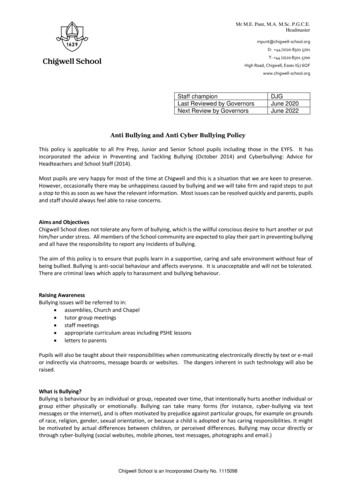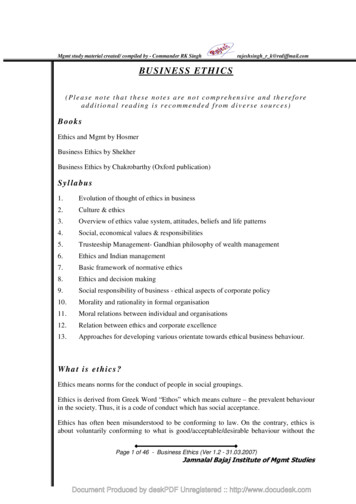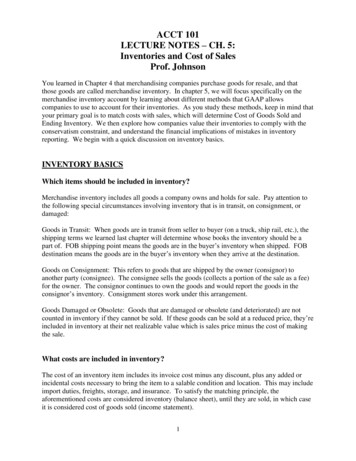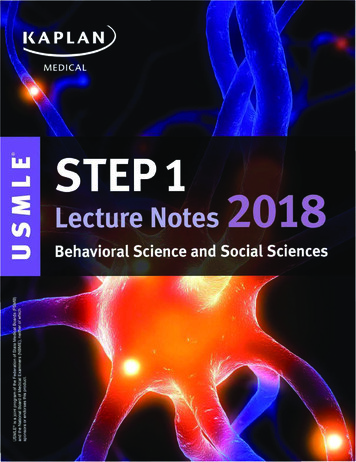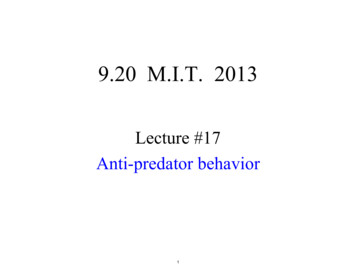
Transcription
9.20 M.I.T. 2013Lecture #17Anti-predator behavior1
Scott ch 7, “Avoiding predation”3. Many predators develop search images byperceptual learning.–Octopus and squid species can counter this ability.What do they do?–How is this related to mimicry as an evolutionarystrategy?Give an example of Batesian or Mullerianmimicry.–p 147, 150-1512
More than only changes in coloration:The “mimic octopus” 1945423(Less than 2 min.)3
Scott ch 7, “Avoiding predation”3. Many predators develop search images byperceptual learning.–Octopus and squid species can counter this ability. Whatdo they do?–How is this related to mimicry as anevolutionary strategy?Give examples of Batesian and Mullerianmimicry.–p 147, 150-1514
Scott ch 7, “Avoiding predation”3.Many predators develop search images by perceptual learning.Octopus and squid species can counter this ability. How?p 147Related concept: Mimicry, pp 150-151:Mullerian mimicry—different unpalatable species lookalike, e.g., different species of Vespid wasps.Batesian mimicry—A palatable species evolves so itlooks like another species that is bad to eat, e.g., like amonarch butterfly. Digger wasps are avoided becausethey resemble the unpalatable Vespid wasps.5
Vespid wasps: examples of two speciesRight is courtesy of kim fleming on Flickr. License CC BY-NC-SA.Left is courtesy of Scott Sherrill-Mix on Flickr. License CC BY-NC.The probability of any individual vespid wasp being eaten is reduced whenany wasp of any of the vespids is eaten, thus, Mullerian mimicry has evolved.6
Monarch butterflyand a mimic—one ofseveral species that havcevolved to look likemonarchs, i.e., theirappearance mimics themonarch.Photo on left courtesy of cotinis on Flickr. License CC BY-NC-SA.Male monarch butterflyThe viceroy species hasevolved by Batesianmimicry of the monarch.Photo in middle courtesy of Alan Vernonon Flickr. License CC BY-NC-SA.Female monarch.7Photo on right courtesy of Benny Mazuron Flickr. License CC BY.Viceroy butterfly (Limenitis archippus)
Scott ch 7, “Avoiding predation”4. Some ground-nesting birds make nests that are onrelatively open ground, making them fairlyconspicuous. What advantage does this have?What can they do to protect their nest from an approachingfox or polecat?Give examples.See p 148-149, on plovers and their four strategies8
Black-headed Plover and Piping PloverPhoto removed due to copyright restrictions.9
Scott ch 7, “Avoiding predation”Predator distraction displays: examples from ploverbehaviorAfter seeing a predator, the bird leaves the nest quietly andthen engages in one of four strategies:1)2)3)4)Attract predator to a false nest (cf. the male sticklebackfish, who does this to lure females away from his real nest)Approach predator in tall grass, then suddenly duck downand imitate a fleeing rodent—moving away from the nestRun towards the predator, calling loudly, then turn away atthe last second, moving away from the nestBroken wing display, fleeing in a direction away from nest10
Scott ch 7, “Avoiding predation”This concerns “secondary defense” (reducing the success ofan attack)5. How can a chick caught in the jaws of a predatorsometimes avoid death? Describe two FAPs ofsuch a chick (include both the stimuli and theresponses). p 149-150Do any mammals have such responses?11
Scott ch 7, “Avoiding predation”This concerns “secondary defense” (reducing the success ofan attack)5.How can a chick caught in the jaws of a predator sometimesavoid death? Describe two FAPs of such a chick (includeboth the stimuli and the responses). p 149-150Do any mammals have such responses?Playing dead: “tonic immobility” Sometimes called thanatosisA major visual trigger: two eyes, forward-looking as inmost predators.Later, the chick shows periodic peeking to see if thepredator is still present. (If so, the tonic immobilitycontinues.)Tonic immobility occurs in small mammals as well. Themost well-known is the opossum.12
Scott ch 7, “Avoiding predation”6. What are two major anti-predator benefits of groupforaging by birds? In analyzing group foraging,what costs must be weighed against these benefits?p 151-155.13
Scott ch 7, “Avoiding predation”6.What are two major anti-predator benefits of group foragingby birds? In analyzing group foraging, what costs must beweighed against these benefits? p 151-155.Benefits: There are at least three:1)2)3)Dilution effect; the “selfish herd”. Increased bysimultaneous reproductionVigilance: reduced demands on an individualConfusion of predatorCosts: Interference from others; competition for food—worse for less-dominant individuals[Remember also the idea of optimum group size (pp155-157) as in the “ideal free distribution” model—independent of the anti-predator effects.]14
Scott ch 7, “Avoiding predation”7. Describe mobbing behavior by birds, including itsfunctions. What examples of mobbing behavior havewe already encountered in class readings anddiscussions?pp 157-15915
Scott ch 7, “Avoiding predation”7. Describe mobbing behavior by birds, including itsfunctions. What examples of mobbing behavior havewe already encountered in class readings anddiscussions?pp 157-159–––Recall the Jackdaws and the geese of Konrad Lorenz.Also, the Meerkats of the Kalahari desert.Note the research results on black-headed gulls (fig 7-5)– Position of nest in colony,– mobbing rate,– rate of loss of eggs to predators16
Scott ch 7, “Avoiding predation”More on “Secondary defense” (reducing the probability ofsuccess of an attack)8.Besides running away, what strategies do some speciesemploy when detected by a predator and attacked – other thanthe method in Q#5? (Some strategies are not described by G.Scott in ch 7.) p 159-161“Misdirecting the attack”, as in some molluscs.Scott’s example: a marine bivalve mollusc with veryconspicuous tenticles. If grabbed, they are shed. They containvery distasteful chemicals so the predator goes away.What is the very successful method used by manylizards?17
Scott ch 7, “Avoiding predation”9. Describe both altruistic and selfish purposes ofalarm calls. Could both kinds of motives haveevolved by natural selection? p 162.Altruistic: Help others in the group, while betrayingown location to the predatorSelfish: Elicit a mass escape and benefit from thedilution and confusion effects.Cresswell’s (1994) data on redshanks: Birds targeted forattack were usually late flyers and non-callers.Also note another effect that alarm calls may have:attracting predators of the attacker.18
Scott ch 7, “Avoiding predation”10. Why is it important for redshanks, a wading bird thatfeeds on large worms, to have evolved two distinctanti-predator behaviors?p 162, 164:19
Scott ch 7, “Avoiding predation”10. Why is it important for redshanks, a wading bird thatfeeds on large worms, to have evolved two distinctanti-predator behaviors?p 162, 164:They have two main predators that have verydifferent techniques of attacking. Redshanks haveevolved responses that are often effective inavoiding each type of attack.-- Peregrine falcons: Crouch low, remain still-- Sparrow hawks: Fly up20
Scott ch 7, “Avoiding predation”11. Describe “stotting” behavior by Thompson’sgazelles. This strange behavior has led scientists tosuggest various hypotheses to explain it. Which issupported by quantitative observations?p 16321
Thompson’s GazellePhoto removed due to copyright restrictions.22
Scott ch 7, “Avoiding predation”11. Describe “stotting” behavior by Thompson’s gazelles. Thisstrange behavior has led scientists to suggest varioushypotheses to explain it. Which is supported by quantitativeobservations?p 163: Three of eleven hypotheses are summarized.One is supported by data from Tim Caro (1986):Attacks by cheetahs are significantly deterred whena gazelle engages in stotting. This behaviorcommunicates to the cat, “I am far enough awaythat I have a high probability of escape. Why wasteyour time and energy?”23
VIDEO“Great Escapes” by Marty Stouffer, WGBH-TVBobcat stalking and chasing a rabbitWild boar chasing a humanAlligator attacking a wild pigJaguar attacking Coati MundiBobcat attacking deer mouseMountain lion/ cougar attacking mule deerBobcat attacking a prairie chickenCoyote attacking ringtailCoyote attacking opossumBadger attacking hog-nose snake (puff adder)Jack rabbit chased by 4 coyotes, then by a goshawkBobcat attacking a legless lizard that sheds its tailExamples of the value of speed, stamina, evasive actions, attackingthe attacker, persistence, playing dead 24
“Four hours in the life of a Syrian hamster”12. Describe adaptive reasons for the Syrian hamster’sbeing a “twilight animal” – neither day-active nornight-active, but active during the dim light of dusk.Right courtesy of Chris Jennings on Flickr. License CC BY-NC-SA.Left courtesy of Su--May on Flickr. License CC BY.Antipredator FAPs: Gait changes in foraging—freezing, running, hiding.IRMs: both visual (overhead or ground level), and olfactory25
“Four hours in the life of a Syrian hamster”13. In a laboratory setting, it is much easier to test ahamster’s visual orienting responses during thedaylight hours, but not in the final two hours of light.–This seems to be counter-intuitive, since it is not thehamster’s most active period.– Explain how it nevertheless makes good sense, from thestandpoint of the hamster’s adaptations.26
14. In the video “Great Escapes”, we see a bobcat attacking aprairie chicken but failing to kill it. The cat appears to beplaying with the bird. Explain this behavior in terms of thedynamics of fixed action patterns as described by K. Lorenz.27
Great Escapes, continued:15.Describe the innate escape reaction of thekangaroo rat to an attacking rattlesnake. The kangaroo rat freezes when it detects thesnake. It waits for the attack. The sound of the onrushing head of theattacking snake elicits a large backward leap. The somersaulting little mammal lands beyondthe reach of the snake.28
16. Are the instincts of antipredator behaviors really“fixed action patterns” as defined by Konrad Lorenzand other ethologists, or are they really bettercharacterized as reflexes? (See class 8.)29
LowestthresholdEndogenousinput30Highestthreshold
Antipredator ASPs:There is not a continuous build up of the level of motivation, as inthe case of hunger, thirst, and many other FAPs.Is the only input to the ASPs for antipredator behaviors from IRMsor learned RMs? (If so, they should probably be called reflexes.)But the answer is “No”: The underlying motivational level can change with time of day(position in the daily cycle of activity). This is endogenous input. It changes with the level of hunger/thirst. It changes with thebackground level of illumination. It changes with inputs from memories: greater in some placesthan in others. It is altered according to time since a predator was last detected:there is considerable "inertia of excitation." An animal cannot change suddenly to another motivational state.31
MIT OpenCourseWarehttp://ocw.mit.edu9.20 Animal BehaviorFall 2013For information about citing these materials or our Terms of Use, visit: http://ocw.mit.edu/terms.
Playing dead: “tonic immobility” A major visual trigger: two eyes, forward-looking as in most predators. Later, the chick shows periodic peeking to see if the predator is still present. (If so, the tonic immobility continues.) Tonic immobility occurs in small mammals as well. The most well-known is the opossum. This concerns “secondary defense” (reducing the success of an attack .



